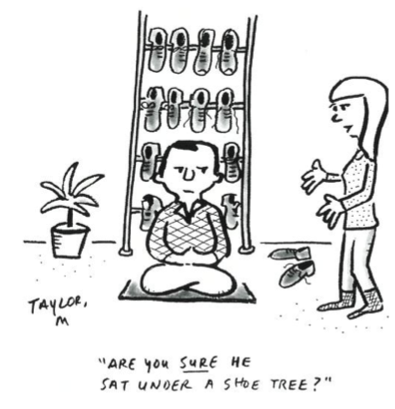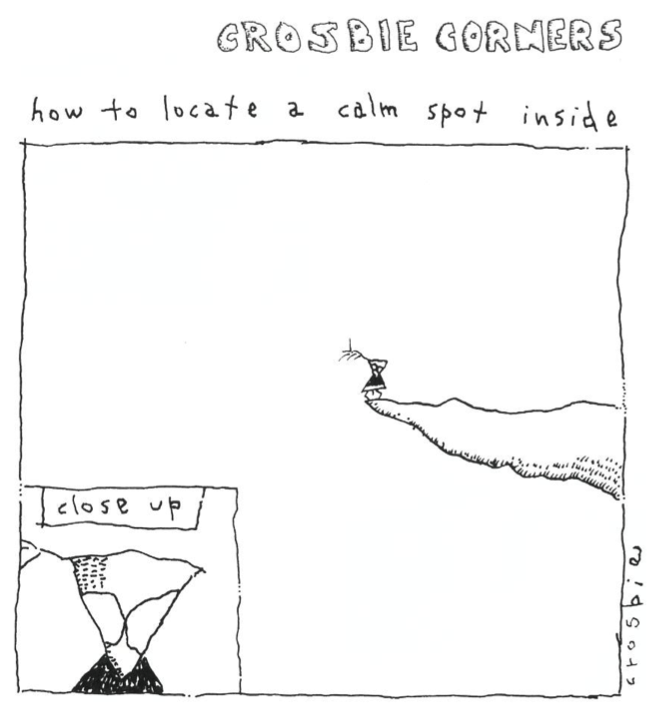Tricycle welcomes letters to the editor. Letters are subject to editing. Please send correspondence to:
Tricycle: The Buddhist Review
92 Vandam Street
New York, NY 10013
Fax: (212) 645-1493
E-mail address: editorial@tricycle.com
Spiritual Bypassing
John Welwood’s article on “The Psychology of Awakening” was a wonderful overview of the difficulty people experience in integrating their intensely spiritual inner awakenings with their sense of ego. We wish to thank Dr. Welwood for sharing his profound insights with us.
However, the article underestimates the influence and power of the practices and the teachings the masters give. When Dr. Welwood states that people “. . . corrupt the true nature of spiritual practice” by using this to compensate for “low self-esteem,” he fails to realize that these spiritual practices are so intrinsically pure that to imagine that they could be corrupted is an underestimation of their power and, also, that these practices are themselves transformative.
When Dr. Welwood adds that some people do service, for example, in a misguided effort to please others, he doesn’t realize that spiritual practices done even for wrong reasons, in the long run, lead to the same place, the same purification, as those done with only pure or high motivation. In fact, we all start for wrong reasons.
The “alienation and low self-esteem” that he speaks of, the lack of trust in one’s own self-wisdom, are precisely what the teachings seek to address and help us resolve. These are our negativities. This is the ego that the teachings and the practices seek to transform.
Elisa Reisner
Merrick, NY
Throughout seven years of sitting practice, the vast majority of the thoughts that have arisen in my mind could fit into two closely linked categories. The first is self-recrimination for having fallen short of an ideal or for being “a disappointment.” And the second is self-condemnation for being continually preoccupied by such thoughts—the nagging voice Welwood calls the “spiritual superego.”
Despite my having repeated daily a practice principle formulated by my teacher—“Each moment, life as it is, the only teacher”—that nagging voice has distracted me from fully realizing the point, namely that seeing and acknowledging the thought as it arises—and experiencing the churning of the gut or the tightening of the shoulder muscles that accompanies it—is indeed authentic practice. Now I see more clearly (and rejoice) that all along I have been doing necessary work, and I feel a new enthusiasm for continuing down this path.
Richard Irwin
Los Angeles, California
Thank you, John Welwood! I really appreciated the article “The Psychology of Awakening.” One of the most frustrating aspects of spirituality has been observing how people use “spiritual bypassing” in order to preserve their defenses! Yes, it is OK to be human; not only OK but it’s necessary. It is one thing to understand Absolute Truth in your mind; it’s another to actualize it and live it from the heart. And the Relative Truth must not be denied. Finally an article that addresses one of the main problems that many teachers fail to understand.
Hallie Krall
Boca Raton, Florida
Solitary Buddhas
I was so pleased to read Nagarjuna’s sage advice on the plight of the “solitary buddha” (Tricycle, Spring 2000). In the modern West, those of us seeking the ground luminosity are almost by default solitary buddhas, as the availability of learned masters and places of study is quite limited.
While we may read a few books or journals regarding the Buddhist way, we rarely come across someone with even a basic understanding of the central philosophical themes of emptiness or cause and effect. Sometimes we find this frustrating.
Therefore, we take refuge in Nagarjuna’s advice that buddhahood can be reached without formal training or monastic seclusion.
Without the benefit of monastic insulation, we are forced to seek the middle path from within the maelstrom of the pages of a day planner.
While this seems a most formidable challenge, the nose of the modern ox can be pierced. Be advised, however, that the beast’s horns have grown longer and sharper over the ages.
Frank Wash
Coopersville, Michigan
On Prayer
I and many I know began praying primarily as a reaction to feeling alone, unloved, frightened, hurt, and angry. As I became less armored against life, my prayer became, “Help me,” said less in desperation and more as a declaration. I was open to being helped. Increasingly surrendered, my next prayer was: “May thy will be done.”

Now I hear that “May the best thing happen. May thy will be done” implies that “the best thing” is not presently happening, “thy will” is not being done now. I see that requesting any changes reveals my dissociation from the constant, seamless changing that is life.
I also feel that prayer emerges from silence, that all we need to do is listen. I see that when we listen without hope, expectation, or demand, prayer becomes a most powerful expression of our native impulse to love and be loved and so care for all beings and things, just as they are.
For me, the final prayer, just before prayer dissolves into ever-loving silence, is: “Thank you.”
Eric Leber
eric@loversleap.org
Kelseyville, California

I read the article on prayer on my way back from a few short days in the Mexico sol. I find a daily reprieve in prayer. So often life presents cunning, baffling, and powerful situations, and prayer is the only solution. “On Prayer” was detailed and easily read. I am in awe of this magazine, and as I live in a remote section of the world, with few face-to-face situations with like-minded fellows, this is a meeting in print.
Augie K
peaceaug@arctic.net
Ring of Fire
Apparently Wendy Johnson is not aware of the harm that Paulownia trees cause here in North America. (“Everything, O Bhikkhus, Is Burning,” Winter 1999) The fast-growing Paulownia is an invasive exotic species. It proliferates aggressively along stream beds and on disturbed ground, crowding out native plants. Insects, birds, and animals thus lose habitat and the entire web of life is diminished. Although some species can adapt to changing conditions, many others cannot adapt and face extinction.
By giving young trees to peace activists, the Green Gulch Farm Zen Center is truly feeding a widening ring of fire. A single Paulownia tree can produce about twenty million seeds that are easily transported long distances by wind and water and may germinate shortly after reaching suitable soil. Alien species such as Paulownia are one of the greatest threats to natural ecosystems and worldwide biodiversity.
I hope the folks at Green Gulch will devise a way to commemorate the bombing of Hiroshima without actually harming innocent species.
Molly Jones
Washington, DC
Wendy Johnson responds:
Thank you for writing about invasive Paulownia trees. I had, of course, never heard this before. We have cautioned our dharma friends who are tending the memorial trees (to date we have distributed ten trees) and I assure you that we will be vigilant and not let the seed escape. I appreciate and resonate with your concern.
Bootstraps and Sutras
Dr. Marston makes an important point (“Quarks 1, Bootstraps 0,” Spring 2000). There is no necessary connection between the language of physics and the language of Buddhism. It is a human trait to mix the ideas of disciplines in a variety of ways. Sometimes this is successful, as when Einstein used an obscure branch of mathematics to describe the physics of his general theory of relativity. Other times, the analogies fall flat. Bootstraps and sutras may be one of those areas. However, there is a simpler appeal to physics for interconnectedness.
The fact that the sun holds earth and moon and me with gravity is very interesting. It is even more interesting when one considers that the gravity of the sun and the gravity of earth and moon and me are one and the same. There is no absolute truth in saying that the sun’s gravity holds the earth, for both distort the same space-time. And that distortion we call gravity runs through the earth and moon and sun and me. It is integral to each of us. The same gravity is also the gravity of every other mass in the universe. There are no boundaries, just the continuous expanse of space-time running through everything. For me, that is enough of Indra’s net.
Chester Gates
In his column, “The Science of Enlightenment,” Brad Marston dismisses the idea that Buddhist philosophy should have any relation to modern physics. He notes that Fritjof Capra, in his celebrated book The Tao of Physics, showed how the “bootstrap hypothesis” in the theory of nuclear particles illustrated Buddhist principles. But then Marston points out that the bootstrap hypothesis didn’t work and has been abandoned in favor of the theory that nuclear particles are made of quarks. He states that “the quark model makes concrete, no-nonsense predictions that have been verified in numerous experiments.”
The Buddhist principle involved here is emptiness, the idea that all things are empty of self-existence, that nothing exists on its own, everything depends on something else for its very existence. This principle says that we cannot break reality down into independent, self-existent, unitary entities. Do quarks violate this principle? Are they self-existent? No! According to current theory, a proton, for example, is made of three quarks held together by gluons, but no one has succeeded in getting a quark out of a proton. The force gets stronger if one tries to push a quark out. So quarks cannot exist unless they are inside of the particles they compose. This is a magnificent illustration of interdependence. And I would be willing to bet that when the quarks are replaced in some future theory by more fundamental entities (strings, perhaps), these will not be self-existent either.
Laura M. Roth
Professor Emerita of Physics, U. at Albany
Practice Coordinator, Albany KTC Buddhist Ctr.
Brad Marston responds to Dr. Roth:
Professor Roth is correct in stating that quarks are confined inside nucleons. But I feel that there is nothing to be gained by invoking complicated quantum physics in an attempt to elucidate Buddhist principles. Everyday life provides ample opportunity to experience emptiness and interdependence.
SGI OK
While I disagree that the Soka Gakkai is a cult, I can see why some people say that it is. There are exclusivist, doctrinaire “practitioners” in the Gakkai, as there probably are in every Buddhist order—but perhaps those in the Gakkai are more vocal in their evangelical zeal.
I am thankful to be a Gakkai member because to me the Gakkai is a sangha of friends and neighbors, a diverse group of people seeking the dharma and its application in daily life. The Gakkai is the people who compose it. Its leaders and administrative/bureaucratic infrastructure are secondary to and, ideally, faithfully of service to the membership. As I understand it, this is the model of “governance” that the Gakkai champions in Japanese politics.
Regarding Daisaku Ikeda, I have noticed that many people tend to fixate on him, either revering him as a Buddha/God or despising him as a modern-day Devadatta. Yet most of the people I know in the Gakkai simply respect him. He’s a great example of an ordinary person who, over the course of five decades, has used the practice of Nichiren Buddhism to become more fully human, more sensitive to the needs of others, and more potently engaged in creating a humane world.
We like him. We love him. We don’t worship him.
Lisa Jones
West Hollywood, California
It has been very heartening of late to see Tricycle’s increasing openness to the Soka Gakkai and the role that it continues to play in bringing Buddhist ideas and practices to the West. In your Fall 1999 issue I was given the opportunity to talk about my own experience of chanting Nam Myoho Renge Kyoand I’m truly grateful that what I said was treated with great editorial respect – more than I could have hoped for from any other magazine.
Unfortunately, given the news item concerning Soka Gakkai in your Spring issue, “Cult Fever in Japan,” it appears thatTricycle feels the need to backtrack. Though I do think these political developments in Japan are newsworthy, I don’t understand why they are painted in such a negative light.
First off, why would anyone allude to Aum Shinrikyo in an article about the Soka Gakkai? Because they’re both Japanese? It’s a little bit like writing a critique of the Catholic Church and then referring to Heaven’s Gate. Second, what is any more “cultish” about the Soka Gakkai than any other spiritual movement? The fact that the people within the organization greatly admire and have a mentor/disciple relationship with Daisaku Ikeda? Is that not a common practice in most forms of Buddhism?

Though it is frustrating, I am not surprised that many people are suspicious of the relationship between the Soka Gakkai and the Komeito party. Publications like Tricycle and the New York Timeshave chosen to depict that relationship as some kind of nefarious collusion and, of course, separation of church and state is one of the pillars of American thought. What no one ever chooses to point out, however, is that, in the incredibly corrupt world of Japanese politics, Komeito has been by far the most scandal-free party. And exactly how separate can church and state ever really be? Would anyone have criticized Baptist churches for supporting particular candidates during the civil rights movement?
Nichiren Daishonin taught that the world of Buddhahood was in no way separate from the affairs of daily life. And, indeed, the goal of the Soka Gakkai is to create a vibrant, functional world infused with a Buddhist sense of individual responsibility and compassion for others. I don’t see why the Soka Gakkai and its members should be looked down upon because they are trying to contribute to creating a more fair, corruption-free democracy in their own country.
I don’t mean to shoot the messenger; perhaps Tricycle is just reporting back to its readership what the New York Times printed in its pages. However, while I might expect this kind of journalistic inaccuracy and lack of objectivity in the Times, I expect more of Tricycle.
Duncan Sheik
New York, NY
Editor’s Reply: Tricycle did indeed rely on stories from major media, including the New York Times, to report the widespread suspicions in Japan about this Buddhist order. The intense coverage that Soka Gakkai in Japan has been receiving in the international press was prompted last year when the prime minister announced a new coalition cabinet which included New Komeito, a political party founded by Soka Gakkai in 1964. We understand why members of Soka Gakkai, especially those outside of Japan, and removed from a national political debate, object to being identified as a “cult.” This designation, however, neither originated with Tricycle nor reflects the editorial view. It does echo the majority of voices and opinion polls in Japan and signals the alarm wherever the separation of church and state is at issue.
 Dharma Rain All Wet
Dharma Rain All Wet
I was disappointed by Alan Hunt-Badiner’s review of Dharma Rain: Sources of Buddhist Environmentalism, edited by Stephanie Kaza and Kenneth Kraft. The book is a remarkable collection of texts spanning the entire Buddhist tradition; even Hunt-Badiner recognizes that it is “the most comprehensive gathering of Buddhist environmental resources to date.”
Recognizing this, why does he devote almost half of the review to decades-old material that is not in the book? (If the “missing” articles were so important, why were they absent from Hunt-Badiner’s own anthology, published ten years ago?) The reviewer seems to have misunderstood Kaza and Kraft’s observation that from the standpoint of established scholarly fields such as religion studies and environmental studies, the academic field of “Buddhism and Ecology” is still in its infancy.
Hunt-Badiner mentions that he would like to see more discussion of “whether Buddhism is being tied too tightly to ecological concerns.” I can think of no better resource for that discussion than Dharma Rain.
William Washburn
Wilmington, Delaware
Correction
In the Spring 2000 issue, Tricycle incorrectly reported on the conflict regarding two young contenders for the leadership of the Kagyu lineage of Tibetan Buddhism. The erroneous reference to “a middle position” came from an article in the New York Times (January 7) which suggested that His Holiness the Dalai Lama had declared that Ugyen Trinley Dorje, the 14-year-old who had just dramatically escaped from Tibet, was the primary reincarnation, while another teenager, Trinlay Thaye Dorje, “could be accepted as a secondary reincarnation.” It is now our understanding that Ugyen Trinley Dorje alone has the support of the Dalai Lama.
After the death of the 16th Karmapa in 1981, four young tulkus accepted responsibility for identifying the new Karmapa and for functioning as regents until that successor was 18 years old.
However, in the wake of the Karmapa’s death, an old rift between two of the regents, Shamar Rinpoche and Tai Situ Rinpoche, flared up. (For further information on the background of this story, see Keith Dowman’s article in the Winter 1992 issue) This dissension ultimately led to each regent standing behind the selection of two separate boys as the one genuine heir to the Karmapa’s seat. Tai Situ endorses Ugyen Trinley Dorje as the single heir, while Shamar Rinpoche endorses Trinlay Thaye Dorje.
Both Tai Situ Rinpoche and Shamar Rinpoche have widespread support in the Himalayas as well as in the West. With Ugyen Trinley’s escape from Tibet, the acrimony between the two regents, and their followers, has once again placed the embittered controversy in the public eye. For now, Nawang Rabgyal, representative of H.H. the Dalai Lama for North and South America, told Tricycle, “Ugyen Trinley was recognized by His Holiness the Dalai Lama as the throne holder of the Tsurphu Monastery in Tibet.” Tricycle regrets this error, and we apologize for contributing misunderstanding to this situation.